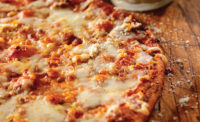Pizza Renaissance
by maria pilar Clark
During the past five decades, pizza has made a name for itself in the tomes of history, and the populace enjoys millions of piping hot pizza pies every day. But, Rome wasn’t built in a day, and pizza wasn’t always the diverse palate-pleaser it is today. Like any culinary Colossus, its origins are shrouded in mystery — it could have been conjured on Mount Olympus, concocted by Ramses’ prized bakers, or even lovingly fashioned in a remote Italian village by a gnarled little nonna. Since that time, manufacturers have been pioneering a pizza renaissance — tweaking, revamping, enhancing and fine-tuning — all to bring a culinary phoenix from the brick-oven’s ashes, leaving consumers singing the praises of times gone by.
Pizza Pedagogy
Common myth tells us that pizza was invented in the home of the Eternal City, however, its beginnings stretch back to ancient Middle Eastern civilizations. Unleavened bread was the base staple for Babylonians, Greeks, Romans, Israelites and Egyptians, who prepared it with local seasonings and topped it with olive oil. Voilá — primitive pizza.
Once the unleavened bread concept made its way to Naples in the late 1800s, Neapolitans added their own flavor to it, resulting in the pizza we think of today.
| Frozen Pizza(For 52 weeks ending Dec. 26, 2004) | ||||||
| Rank | Brand | Dollar Volume (in millions) |
% Change |
Dollar Share |
Unit Sales (in millions) |
% Change |
| 1 | DiGiorno | $501.3 | +6.8 | 19.3 | 98.2 | +10.7 |
| 2 | Tombstone | $284.7 | -2.6 | 10.9 | 84.3 | -1.1 |
| 3 | Red Baron | $239.4 | +1.8 | 9.2 | 74.2 | +1.7 |
| 4 | Freschetta | $189.2 | +0.1 | 7.3 | 37.5 | -4.6 |
| 5 | Private Label | $176.7 | +3.2 | 6.8 | 101.5 | +0.9 |
| TOTAL* | $2,600.1 | +2.1 | 100.0 | 992.9 | +2.3 | |
| *Including brands not shown Source: Information Resources Inc., Supermarkets, Drug Stores and Mass Merchandisers, excluding Wal-Mart | ||||||
Italian royalty was touring the region, and wanting to impress, Raffaele Esposito, a regular Joe Schmoe baker-type chose to prepare a dish showcasing the patriotic enthusiasm of il popolo. When the royals were presented with the chewy flatbread topped with juicy Roma tomatoes, moist mozzarella cheese and fresh-from-the-garden basil (highlighting Italy’s colors), it was an instant hit. As with any sensation, the sincerest form of flattery is imitation. Folks fired up their ovens and pizza starting gaining popularity up and down the boot-shaped country faster than you could say mangia!
By the dawn of the 1900s, pizza had traveled across the Mediterranean Sea to the United States in the recipe books of Italian immigrants. There was pizza profusion in Chicago and New York City, where small mom-and-pop cafés proudly made it their blue-plate special. Americans soon caught on to the gastronomical great and its popularity soared — a tasty tradition was born.
Thin Is In
Today, pizza has developed a new identity, rising above its fame as an American icon, and outgrowing the coveted title it shares with hot dogs and apple pie.
Although traditionally flavored pizza always will have a place in the freezer case, fresh-tasting, portion-conscious, ethnically inspired gourmet pies are elbowing their way onto grocers’ shelves, encouraging adventurous consumers to experiment with an even wider array of choices.
“The frozen-pizza category as a whole has continued to expand both in annual sales and new product introductions,” says Michael Pellegrino, senior vice president and general manager for Kraft Pizza Company. “While traditional flavors such as cheese, sausage and pepperoni always will be popular, consumers are … willing to experiment with new tastes, including more intense flavors on their pizza.”
Pizza manufacturers are meeting this bold, daring side of consumers head on with fresh, innovative varieties. These days, consumers want everything when it comes to their pizza choices — convenience, portability, premium quality, more good-for-you options and no shortcuts when it comes to taste!
According to Pellegrino, Kraft’s California Pizza Kitchen (CPK) line, boasting flavors such as Thai Chicken, BBQ Chicken and Jamaican Jerk “is a perfect example of how the freezer case is being used to deliver more non-traditional, ethnic sauces and unique ingredients — just like on a restaurant menu.”
On top of that, thin crust is igniting the frozen-pizza category as consumers move toward finding a balance between perpetual weight watching and fulfilling their cravings for something truly indulgent.
“In 2004, we introduced our new DiGiorno Thin Crispy Crust line and Tombstone Brick Oven-Style [pizzas], and they have done very well,” says Pellegrino.
Kraft is leading the “thin is in” trend and will unveil its latest pizza creation later this month — CPK Crispy Thin Crust. The line will have three flavorful varieties, channeling the unique offerings one seldom finds outside of a cheery little Italian pizzeria.
The Sicilian pizza will include zesty marinara sauce topped with spicy ham, Italian sausage, salami, varied cheeses and basil. The Margherita pizza will feature a blend of olive oil, fresh tomatoes, cheeses and basil, while the White Pizza, the most unique in the line, highlights the tastes of spinach in garlic and oil, blended with shredded and fresh Mozzarella, Fontina, Romano and Parmesan cheeses.
Schwan’s Consumer Brands is also brandishing its thin crust high with the development of its new Freschetta Brick Oven pizzas — the first-to-market of their kind in the frozen-pizza category.
The pizzas have a thinner, crispier crust, reminiscent of a pizza that tastes like it was “baked in a brick oven over an open flame,” says Darci Eckermann, director of marketing services for Schwan’s Consumer Brands, North America.
Each pizza is available in a 12-in. version, but due to overwhelming success, Schwan’s added an 8-in. pizza to the line, ideal for one- to two-person households. There are five varieties, the most popular of which are Barbeque Chicken and Smoked Ham and Portobello Mushroom.
“As consumers’ lifestyles change and life experiences broaden through ethnic foods and travel, they continue to expect more from their frozen pizza,” says Eckermann. “It is our job to develop new, innovative products that meet, and even anticipate, consumers’ needs.”
The company has experienced repeat success with its Freschetta 12-in. Hand-Tossed Style pizza, formerly known as Freschetta Rising Crust. Consumers like the restaurant-style crust and gourmet varieties, including Three-Cheese, Tomato and Basil, and Canadian Bacon and Pineapple.
Eckermann indicates that the Canadian Bacon and Pineapple flavor is the first frozen pizza of its kind in national distribution, and is meeting with consumer approval across the board.
Therein lies the key to filling consumers’ bellies — staying on the lookout for what consumers want most from their frozen pizza and delivering on those “wants.”
| Frozen Pizza(For 52 weeks ending Dec. 26, 2004) | ||||||
| Rank | Brand | Dollar Volume (in millions) |
% Change |
Dollar Share |
Unit Sales (in millions) |
% Change |
| 1 | Kraft Foods Inc. | $844.4 | +2.2 | 32.5 | 193.6 | +3.9 |
| 2 | Tony’s Pizza Srvc. | $711.7 | -0.2 | 27.4 | 215.8 | -0.5 |
| 3 | General Mills | $218.0 | -0.6 | 8.4 | 193.2 | +2.3 |
| 4 | Private Label | $176.7 | +3.2 | 6.8 | 101.5 | +0.9 |
| 5 | Nestle USA Inc. | $165.0 | +26.4 | 6.3 | 63.4 | +29.6 |
| TOTAL* | $2,600.1 | +2.1 | 100.0 | 992.9 | +2.3 | |
| *Including brands not shown Source: Information Resources Inc., Supermarkets, Drug Stores and Mass Merchandisers, excluding Wal-Mart | ||||||
“Schwan’s continues to be a leader in gathering consumer insights and developing research to support retailers with tactics that integrate with their strategies,” adds Eckermann. “Schwan’s understands that success is achieved by being consumer-driven. Developing innovative and successful new products requires manufacturers to know and understand consumer trends.”
Mystic Pizza
There are those consumers who relish in the familiar — a comforting, traditional slice of pizza with no surprises or exotic inclusions. These mystics consider consuming pizza therapeutic, and have banded together to form a pizza-therapy movement founded on the principles of delicious simplicity.
Pizza manufacturers in turn, are embracing those loyal traditionalists by reworking their time-honored recipes to meet ongoing consumer requests for healthier pizzas produced with wholesome ingredients and no trans fat — just the choices pizza-therapy devotees might find most appealing while staying true to pizza’s fundamental roots.
Among those companies specializing in the traditional is Home Run Inn. According to Angela Ginex, frozen food marketing manager for the company, “Home Run Inn has been using the same pizza recipe since 1947. The pizzas are made from all-natural ingredients. … [They] do not contain trans fats, preservatives, hydrogenated oil or MSG.”
Home Run Inn recently introduced its new frozen, deep-dish pizza — Perrino’s Premium Deep Dish. The Chicago-style pie is a culinary mecca for traditional deep-dish connoisseurs, and is available in three deliciously conventional varieties — cheese, sausage and pepperoni. Like all Home Run Inn pizzas, Perrino’s uses an all natural pizza recipe, baking up golden and bubbly in about 20 minutes.
“People are searching for healthy food that tastes good,” says Ginex. “Home Run Inn pizza and Perrino’s Deep Dish offer consumers exceptional-tasting pizza that is all-natural and trans fat-free. … Parents can feel confident that they are feeding their kids a healthy meal when serving Home Run Inn pizza.”
The company also offers microwaveable 6-in. personal pizzas under the Home Run Inn brand, available in Home Run Inn’s most popular flavors. A grilled vegetable, 6-in. variety recently joined the cheese-sausage-pepperoni club, designed to target those consumers whose taste buds like to try something new one small bite at a time.
Ontario-based Molinaro’s Fine Italian Foods Ltd. has formed a partnership with 7-11 stores to launch its new Pizza Express line. Using traditional family recipes, the microwaveable pizzas come in conventional flavors that can go from microwave to mouth in one minute.
Kraft also debuted an innovative microwaveable product to consumers in 2004. Its DiGiorno Microwave Rising Crust Pizza is the first and only premium frozen pizza that rises and delivers oven-baked taste from the microwave in only five minutes.
“Convenience continues to play a key role in the popularity of frozen pizza today,” says Pellegrino. “Just because consumers are demanding innovation, great taste and variety doesn’t mean they want to sacrifice on convenience.”
Launching a new spin on carryout, microwaveable pizza products boast convenience, portability and portion control. What’s more, consumers have an alternative to burgers and can enjoy an economical, hot, tasty lunch made with quality ingredients in a fraction of the time it would take to nosh on the same lunch in a restaurant. Now that’s delivery!
Pizza Party
As consumer interest in serving size, the health-and-wellness movement and the influence of ethnic cuisine on down-home American fare is on the rise, manufacturers are coming up with original products to satisfy consumers and stay on-trend.
In a nod to portion control, Schwan’s rolled out Red Baron Deep Dish Minis, Red Baron Singles and Red Baron Stuffed Pizza Slices. Its Freschetta 8-in. Rising Crust pizza and 8-in. Freschetta Brick Oven pizza recently joined the group along with Tony’s Pizza For One, Tony’s Pouches and Tony’s Deep Dish Pizza.
Ideal for those who want to indulge in moderation, each product requires minimal preparation time for maximum enjoyment time.
Even though consumers are seeking out smaller servings, they still want lots of ooey-gooey pizza goodness, and plenty of bang for their buck.
“Consumers, especially those with kids, are continuing to seek added value with their frozen-pizza selections,” says Eckermann. “Tony’s is a value brand targeted to moms looking for added value along with a convenient and great-tasting pizza their kids will love.”
What’s more, although the low-carb trend is waning, some devout “carbies” are holding fast to their low-carb beliefs. Schwan’s offers those consumers its Carb Works Pizza and Carb Works French Bread Pizza under its Red Baron brand.
“The Red Baron Carb Works French Bread pizza is the first and only lower-carb, frozen French bread pizza available to consumers in grocery stores,” notes Eckermann. “The Red Baron Carb Works pizza and French bread also provide carb-conscious consumers with great taste and convenience.”
With varieties such as Pepperoni, Three Cheese, Special Deluxe and Sausage & Pepperoni for its Carb Works pizza and Pepperoni, Five Cheese, Supreme and Meat Trio for its Carb Works French bread, carb-watchers and carb-eaters alike can enjoy each tasty, flavor.
Kraft is dedicating some new products to consumers bent on consuming only nutritionally sound products. Its new Boca Rising Crust pizza offers consumers a healthful meatless pizza alternative, while its new line of South Beach Diet frozen pizzas, debuting this spring, will feature ingredients such as grilled chicken and vegetables with a whole-grain crust.
“Consumers are interested in great-tasting, better-for-you options,” says Pellegrino. “We are always focused on offering consumers what they are interested in, and we know they are asking for great-tasting, nutrition-focused options.”
Kraft is also undergoing a product makeover, as part of its overall health-and-wellness initiative. The company is challenging itself with a plan to develop new products with a health-and-wellness benefit and to improve the nutritional content of existing products.
“An important part of our reformulation efforts is to reduce or wherever possible, eliminate trans fat from Kraft products,” adds Pellegrino. “Our overall goal is to make significant trans-fat reductions, while maintaining the taste and functionality consumers expect.”
In addition, Schwan’s has strategically been working to reformulate its products in order to address consumers’ better-for-you product requests.
“We have been reviewing and evaluating our product line and beginning this year, many of our products have been reformulated to have either a reduced level, or no trans fat, while maintaining the taste profile consumers want,” says Eckermann.
Pellegrino notes that overall, frozen-pizza sales have risen steadily from $1.5 billion in 1995, to over $2.5 billion in 2005.
“Pizza continues to be a destination product for shoppers in store and a universally loved food that’s versatile enough to fit many occasions,” says Pellegrino. “Consumers purchase [pizza] regularly as a meal staple because of its great taste and convenience.”
As pizza product innovations continue to introduce new eating occasions, pizza lovers want more quality, premium ingredients and convenience reflected in their pies.
“Convenience and portability are two common trends in the marketplace that demand manufacturers’ attention,” explains Eckermann. “Developing innovative and successful new products requires manufacturers to know and understand consumer trends.”
Eckermann notes that the AC Nielsen report ending Jan. 8, 2005, showed that sales in the super-premium pizza segment were up 4.5% overall.
“Freschetta 12-in. Brick Oven pizza is driving the growth with an increase of 35% versus a year ago. Within the value segment, Tony’s Original 10-in. [pizza] has also seen double digit growth of 13.5% and Tony’s Pizza For One [saw] an increase of 3.5%.”
No matter how you slice it, manufacturers are realizing a renaissance in their own pizza-driven empire — bringing innovation to the category, keeping their cooks in the kitchen and firing up their marketing campaigns. In an ongoing effort to tackle consumer trends head on, manufacturers are hustling to bring to market the frozen-pizza products that consumers crave.



